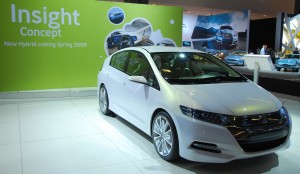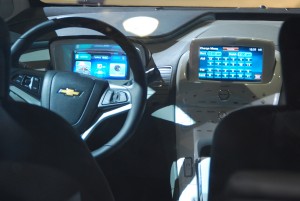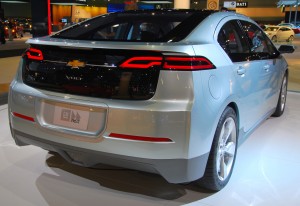
By Evan Ackerman
Looking forward to this year’s LA Auto Show, I was hoping to see something to reassure me that things are seriously happening towards innovating our way out of a gasoline dependent transport economy. Aaaaand I didn’t really get that, at all. There were lots of impressive concepts, to be sure, and a lot of talk about sustainability and green initiatives and crap. But what are people actually producing? Nothing especially remarkable, with a few exceptions.
First of all, just about everything is a hybrid. Which is good, I guess… Or I should say, it’s better than things not being hybrids. The thing is, though, that just because something is a hybrid doesn’t mean it gets significantly better (or even good) gas mileage. At least, that’s the way it seemed from just walking around the show looking at the EPA estimated mpg stickers. Why is this the case? I think it’s because car manufacturers (and car buyers) are still for some silly reason concerned with maximizing horsepower, which is most of the time useless after a certain point. But maybe my 95 Volvo and I are just jealous. Most new cars were distinctly unimpressive when it came to gas mileage, whether they were hybrids or not.
Also, everybody’s got a fuel cell car or light SUV now, but most of them are sort of “hey look, we can do it too!” vehicles rather than a serious production effort. And of course, nobody’s been able to solve the crucial problem: distribution. I think BMW has had the most promising interim solution (and has for years) in the Hydrogen 7 gas/hydrogen hybrid, but it wasn’t at the show… Rather, BMW was promoting a system to make gas engines up to 20% more efficient by dynamically controlling power output. That’s nice and all, but gasoline should be the past, not the future.
Is it too much for me to expect that automakers asking for a financial bailout should be trying new things and not just taking existing cars and retrofitting them with hybrid engines to eke out a few extra MPG? Maybe it is, I suppose it’s cheaper to do that than to make a serious commitment to a new technology that might not prove to be adoptable mainstream. But there is some good and important work going on, using technology that makes a substantial difference to efficiency and eco-friendliness. Have a look, after the jump.
We’ll start off with a car that I’ve written about before: the Honda FCX Clarity. The Clarity is a production ready car powered exclusively by hydrogen. Honda has tackled the problem of hydrogen distribution by creating the Home Energy Station, a box that plugs into your natural gas line at home and creates heat and electricity while making hydrogen for your car. That still doesn’t help if you want to drive long distances (over about 250 miles), but at least it turns the Clarity into a practical commuter. If you live in the LA area, you can sign up to rent a Clarity for about $600 a month.
The Clarity might not quite be ready for primetime yet, but in the meantime, Honda is working on some short term solutions, one of which is the 2009 Honda Insight. While the original Insight managed 70 mpg, the second generation will most likely not be quite as efficient, with estimates placing it somewhere between 40 and 67 mpg. It’ll be a little friendlier, though, with seating for four and a hatchback… Basically, it’s Honda’s take on the Toyota Prius. It’ll also be relatively cheap: scheduled for an April 2009 release, it should start at around $19,000.
If the Insight isn’t sporty enough for you, Honda has a third eco-turnative™: the CR-Z. Details are a bit scarce on this one, but it’s supposed to follow the launch of the Insight in late 2009 or 2010 starting at $31,000.
Not content with hydrogen cars and electric hybrids, Honda is also trying out natural gas power. Like the Clarity, the problem with the Honda Civic GX is finding sources of natural gas to fuel the car, so also like the Clarity, Honda has a solution in the form of a home fueling station.
The Phill natural gas fueling station taps into the natural gas line which comes into your home if you have a gas stove, and will fuel your car automatically overnight. That’s the downside, though… A complete refueling takes 16 hours. Overnight refueling is only possible if you drive your car 100 miles a day or less, but that’s true for most people most of the time. And if you’re going on a road trip, well, there are other places to get natural gas fuel (quickly), as long as you don’t try to leave California.
As for the car itself, the mileage is decent enough (24 city 36 highway), but natural gas is also a lot cheaper (and more stable in price) than gasoline, and is nearly emission free. The GX delivers 118 hp with a range of 250 miles, and costs $25,000.
Honda Civic at LemonFree.com
Toyota Camry CNG Hybrid Concept
Believe it or not, Honda isn’t the only one going the eco-friendly route. It just seems that way ’cause they’re being so proactive about it. But other companies have Natural Gas Vehicles, like the CNG Camry Hybrid from Toyota. The Camry is unique in that it’s a hybrid, using the same hybrid system as current hybrids, just with natural gas instead of gasoline. The 4 cylinder engine outputs up to 170 horsepower with the electrics kicking in, and you’ll get almost exactly the same efficiency as a conventional Camry hybrid. The range of the CNG Camry is about 250 miles, but Toyota doesn’t say much on the subject of refueling.
As friendly as hydrogen and natural gas are, we just don’t have the infrastructure for them yet. It sucks, but it’s a fact. The eco-friendly power source that we do have an infrastructure for is electricity, and the Mini E takes advantage of that. It has a 220 hp electric motor under the hood, and uses a lithium battery pack to achieve a range of just over 100 miles in mixed driving. It’ll go 0-60 in 8.5 seconds with an electronically limited top speed of 95 mph.
Although you can recharge the Mini E from a standard outlet, doing so takes over 26 (!) hours. You really need 32 amps at 240 volts to get the time down to a more reasonable 4.5 hours, or if you live next to the Hoover Dam, 48 amps at 240 volts will charge the car in 3 hours.
Some 500 Mini Es have been made available to the public in California, New York, and New Jersey for $850 a month which includes maintenance and insurance. Needless to say, they’ve all be spoken for already, but you can sign up for updates on the Mini E (I guess it’s pronounced “Minnie”) website.
Vehicles like the Tesla Roadster have taken advantage of the massive amounts of power offered by electric motors, and Dodge is next in line to realize that electric sports cars are serious amounts of awesome.
Based on the Lotus Evora chassis, the Dodge EV has a 268 hp motor that can go 0-60 in under 5 silent seconds and surpass 120 mph just as quietly. It has a range of 150-200 miles, and can recharge completely in 8 hours from a standard outlet, or in 4 hours from a 220 volt appliance outlet. No price, availability, or alternate color information as of yet.
Last but certainly not least is what seems to be the best hope for a practical consumer electric hybrid car: the Chevy Volt. Just to recap, the Volt can recharge from a wall outlet and travel 40 miles (more than what most people drive in a day) on electricity alone. For longer trips, a gas engine kicks in to boost the range to 400 miles, and you can keep filling the tank and drive as long as you want. So for most people, the Volt will be an electric car most of the time, but thanks to the hybrid gas system, you don’t get all the range limiting downsides of pure electric operation.
This was my first chance to see the production design of the Chevy Volt in the flesh, and I was honestly surprised by how good it looked. Don’t get me wrong, I still like the original concept design a lot better. But having seen the new Volt in person, I’m willing to revise my initial impression of it and say that yes, I do like the production version, even if it has a slightly lesser degree of badassness.
The Volt is currently scheduled for a 2010 release for somewhere between $30,000 and $40,000, but a lot of bad stuff could potentially happen to the auto industry between now and then. I’m just hoping that the Volt, and vehicles like it, will turn out to be the solution to the problem, instead of something to cut to temporarily solve it.
[ LA Auto Show ]

























